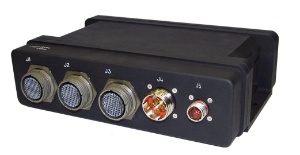Jun 5 2010
SIU6, a compact, sturdy sensor interface unit with embedded I/O system has been recently announced by North Atlantic Industries (NAI). The sensor is designed to remotely process, acquire, and distribute data for applications relating to platform monitoring and control systems. It is suited for sturdy aerospace and military applications like command and control, engine monitoring, navigation, guidance, and weapons targeting.
The SIU6 derives benefits of the multifunction I/O, high density, and power supply products of NAI and delivers a broad range of communication and I/O products like CANBus, A/D, D/A, ARINC 429, TTL, RTD, high speed Sync/Async RS232/422/485,
Discrete I/O, BC/RT/MT MIL-STD-1553, Synchro/Resolver-to-Digital and LVDT, Digital-to-Synchro/Resolver and DLV.
 North Atlantic Industries The SIU6 is the most compact rugged chassis touting optional processing and 300 IO signals
North Atlantic Industries The SIU6 is the most compact rugged chassis touting optional processing and 300 IO signals
An option is available for Low Power Blackfin processor module of Analog Devices or Freescale PowerPC to facilitate raw I/O function data processing. Analog Devices Tool Kit or VxWorks 6.x BSP is also supported.
This base-plate cooled system’s high functional density incorporates COTS multifunction I/O boards as well as an integrated sturdy power supply. The sturdy chassis can function under harsh environments like vibration, EMI, extreme temperature, and shock. The need for custom wiring requirement has been obviated through an integrated connector for the backplane architecture. A maximum of 300 I/O signals and two 10/100/1000BaseT Ethernet type of ports are also supported.
NAI’s V.P. of Sales and Marketing. Lino Massafra informed that the SI6 has the most compact rugged chassis that features optional processing as well as 300 I/O signals. He explained that it is possible to share centralized places for processing, acquisition, and distribution of I/O data over Ethernet, ARINC429, MIL-STD-1553, Serial or CANBus Serial buses, which need less wiring, result in enhancing system reliability, and lowering SWaP as well as EMI/EMC susceptibility.